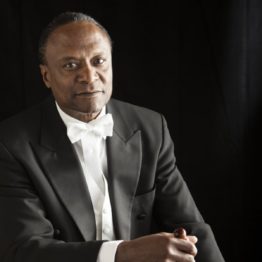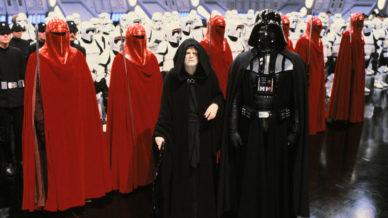

Bernstein’s West Side Story & Gershwin’s Piano Concerto
April 22 – 24, 2022
THOMAS WILKINS conducts
JOYCE YANG piano
FLORENCE PRICE Dances In The Canebrakes
GERSHWIN Piano Concerto In F
ULYSSES KAY Overture To Theatre Set
BERNSTEIN West Side Story: Symphonic Dances
BERNSTEIN “America”, from West Side Story
Bernstein’s most beloved score comes to life with the DSO. The timeless story of love in the face of racial intolerance, based on Romeo and Juliet, is as relevant today as it was when it debuted on Broadway in 1957.
Dazzling, award-winning pianist Joyce Yang, who feels that Gershwin’s Piano Concerto is full of optimism, hope and magic, will fill the Meyerson with just that for this concert event.
For information on our COVID-19 safety protocols, please visit here.

Program Notes
by René Spencer Saller
Make no mistake: Florence Price may not be a household name, but she was always extraordinary. Born Florence Beatrice Smith, in Little Rock, Arkansas, to a dentist father and a piano teacher mother, she gave her first piano recital at age four and had her first composition published a mere seven years later. She graduated from her segregated Catholic high school at age 14, as the class valedictorian. She studied piano and organ at the New England Conservatory in Boston—one of the few music schools that admitted Black students—and graduated with honors in 1906, earning double degrees in organ and music education.
After graduation, Price was hired to direct the music department at Clark Atlanta University in Atlanta. In 1912 she married the attorney Thomas J. Price, with whom she had two daughters and a son. They lived in Price’s hometown of Little Rock until 1927, when a public lynching motivated them to leave the Jim Crow South.
Like so many Black families during the Great Migration, the Prices moved northward in 1927, mainly to find greater opportunity in what they hoped would be a less racist environment. Inspired by Chicago’s active music culture, Price entered an especially fertile period as a composer and began to establish herself as a concert pianist and organist, all the while making ends meet as a piano teacher, silent-film organist, and advertising-jingle writer.
In 1931 Price divorced her husband and moved in with a female friend. She also formed important friendships and creative collaborations with Black singers, most notably the legendary contralto Marian Anderson. In 1932 her Symphony No. 1 in E Minor won the Wanamaker Composition Contest and was performed the following year by the Chicago Symphony Orchestra, led by Frederick Stock.
In general, however, Price found herself limited by her country’s institutional sexism and racism. In 1943, she practically begged Boston Symphony Orchestra music director Serge Koussevitzky to program her work: “I have two handicaps,” she wrote, “those of sex and race.” “I am a woman, and I have some Negro blood in my veins.”
She never heard back from Koussevitzky. Unfortunately, Price would find herself shut out of the concert music establishment, her sizable body of work all but forgotten.
Price wrote Dances in the Canebrakes for solo piano in 1953. She would die later that year from a stroke. The orchestral suite was created shortly after Price’s death by the prominent African American composer, arranger, and pedagogue William Grant Still (1895–1978).
Even though Price composed more than 300 works, including four symphonies, four concertos, and numerous works for chorus and chamber settings, her work was neglected during her lifetime and for decades after her death. In 2009 a trove of her unpublished music was accidentally unearthed in her former summer house in St. Anne, Illinois. Since then, musicologists have managed to reconstruct certain pieces that were previously assumed to be lost or incomplete, and Price’s music is enjoying a long overdue revival.
A Closer Listen
Dances in the Canebrakes comprises three continuous movements, each assigned its own descriptive title. The first, “Nimble Feet,” weaves Joplinesque ragtime riffs into late Romantic tapestries. The second, “Tropical Noon,” deploys a “slow-drag” style with syncopated swing rhythms. In this central movement, Price contrasts a dreamy, lyrical section with a sharper, more aggressive segment. The finale, “Silk Hat and Walking Cane,” evokes both the fashionable wooden canes wielded by the ballroom set and the “cane” of the “canebrakes.” The canebrakes were dense thickets of cane, tall, tough invasive grasses that teams of enslaved Black people were forced to clear so that cotton could be planted. The task often lasted several days, which meant that the laborers might set up camp and enjoy some music making during a rare moment of leisure.
The original dances in the canebrakes, Price’s title reminds us, took place not in the ballrooms but in the swamps and marshes, on brutal worksites, where they were performed by enslaved people of African descent, people wearing kerchiefs and straw hats, certainly not silk and other fancy finery. Price’s music occupies a rarefied realm all its own, somehow containing both ballroom and canebrake, dandy and chattel, leisure and toil.
“I’m trying mainly to be American in the feeling of my music,” George Gershwin explained in 1936, a year before he fell into a fatal coma caused by a brain tumor. Nailing our national sound is tricky: American culture has always been a hodgepodge. Gershwin’s style was a potent elixir of jazz, blues, art song, sacred Hebrew laments, Eastern-European hoedowns, and Broadway balladeering. The Great American Songbook was still under construction, still unnamed, and Gershwin, although he couldn’t possibly know it at the time, was one of its main authors.
His parents, poor Russian Jews, immigrated in the early 1890s. They met and married in New York, first settling in a Jewish neighborhood on the Lower East Side. Ira, their first son, was born in 1896. Two years later, when George came along, the family was living in Brooklyn and had changed its name from Gershovitz to Gershvin. George, whose given name was Jacob, eventually changed his surname to “Gershwin,” and the rest of the family followed suit.
Although George didn’t start playing piano until he was 12, his gift was obvious. By his mid-teens, he was earning $15 a week writing songs on Tin Pan Alley. After a few years as a rehearsal pianist on Broadway, he got a job writing tunes for a music publisher. In 1919 he delivered his first big hit, “Swanee,” with lyrics by Irving Caesar. In collaboration with Ira, a gifted lyricist, he went on to pen a slew of Broadway hits.
Classic Chutzpah
After being wowed by the first Carnegie Hall performance of Rhapsody in Blue, the conductor Walter Damrosch commissioned from Gershwin a concerto for piano and orchestra. Gershwin composed the Piano Concerto in F between July 22 and November 10, 1925. The premiere took place on December 3, 1925, with the composer playing piano.
After accepting Damrosch’s commission, Gershwin immediately bought a book on composition. Despite several years of formal training in harmony and orchestration, he wasn’t prepared to wing it. He intended to write a legitimate concerto, consistent with the conventions of sonata form.
He did all that and more with his Piano Concerto, a heady cocktail of European classicism and American chutzpah. Gershwin follows most of the old rules, but his ultra-contemporary sound world would have alarmed Brahms and his circle. Zesty brass and tempestuous percussion dominate the opening moments of the Allegro, and then the soloist conjures up a maelstrom of variations, ranging from delirious to demonic. Here Gershwin lays out most of the musical ideas that will animate the next two movements. A microcosm of the entire concerto, this Allegro contains multitudes.
In the bluesy Adagio, mood-indigo piano and muted trumpet give way to the hypnotic hustle of the Andante con moto, which wraps up the central movement. The closing Allegro agitato, a hectic reprise of earlier thematic material, brings a bit of Broadway swagger to its “grandioso” restatement of the main theme.
The nephew of the influential jazz musician King Oliver, Kay started playing piano, violin, and saxophone as a child. He attended the University of Arizona, where he attracted the notice of William Grant Still, who served as an early mentor. During his graduate studies at the Eastman School of Music, Kay studied under Howard Hanson. From 1941-42, he undertook further study at Yale with world-renowned violist and neoclassical composer Paul Hindemith.
During World War II, Kay served as a musician in the United States Navy, and then won a grant that allowed him to enroll at Columbia University, where he embarked on further study with Otto Luening. From 1949 to 1953 he lived and studied in Rome, on a Fulbright Scholarship augmented by the prestigious Prix de Rome, which Kay won twice. After returning from Italy, Kay worked for the performance rights organization Broadcast Music, Inc. until 1968, when he was named distinguished professor at Lehman College of the City University of New York. He taught there for 20 years before retiring.
In 1958 Kay was appointed by the U.S. State Department to represent the United States on a tour of the Soviet Union, a kind of composers’ summit that also included Roger Sessions, Peter Mennin, and Roy Harris (the following year, Dmitri Shostakovich and Dmitri Kabalevsky traveled to the United States as part of the Soviet delegation). By 1960 Kay was famous enough to appear in an ad for Lucky Strike cigarettes in Ebony magazine.
In addition to his numerous symphonic and choral works, Kay wrote five operas. The New Jersey State Opera staged the first performance of his final opera, Frederick Douglass, in 1991. Four years later, he died, at age 78, from complications of Parkinson’s disease.
Kay wrote Theatre Set in 1968 on a commission from the Junior League of Atlanta. It is structured in three movements: Overture, Ballad-Chase Music, and “Finale.” Kay called it his tribute to “show music without quoting any popular theater tunes.”
He dedicated it to the conductor Robert Shaw, who led the Atlanta Symphony Orchestra in the premiere later that year.
Bernstein wrote the music for West Side Story in 1957, after years of collaboration on abandoned drafts. The musical, an urbanized reboot of Shakespeare’s Romeo and Juliet with feuding teenage gang members in place of Capulets and Montagues, was a smash hit from opening night. Four years later, Bernstein extracted nine sections of the score to create an orchestral suite, which he titled Symphonic Dances from West Side Story. With its poignant love themes (from “Maria” and “Somewhere”), hot Cuban rhythms, and sexy/cool syncopation, the suite conveys the script’s pathos and danger without using any words except “Mambo,” which Bernstein indicated should be shouted by the musicians at prescribed intervals.
With lyrics penned by the young (and then relatively unknown) Stephen Sondheim, “America” is one of the most memorable songs in West Side Story. Sondheim’s savagely acerbic lyrics were adapted slightly to reflect certain plot changes in the film version, but all the propulsive energy and sarcastic humor remain intact. Bernstein’s tempo instruction is Tempo di Huapango, referring to an intricate Mexican folk dance style typically performed on wooden platforms. Characterized by a complex rhythmic structure derived from mixed double and triple meters—Bernstein’s music features alternating bars of 6/8 and 3/4—the classical huapango is danced by couples, often in large groups. Sometimes the dancing couples exchange sassy banter, as the male and female Sharks do in the film versions of West Side Story.
Sondheim, who died last November, said that Bernstein claimed to have encountered the huapango dance rhythm while on vacation in Puerto Rico, which gave him the idea for the song. Several years later, while going through a box of Bernstein’s papers, one of Sondheim’s friends unearthed an unproduced ballet called Conch Town that included the same tune. Sondheim believed that Bernstein made up the vacation story so that the tune would seem more relevant to his current project. At any rate, given what Bernstein did with the music, we can’t complain if he chose to recycle a worthy but forgotten melody to serve a better story.




